Sometimes, no matter what you try, your dog will absolutely hate putting a leash on. When I first tried putting a lead on my pooch, he lunged so hard that he got terrible chafing from his collar!
I had to spend forever teaching him proper leash manners through positive reinforcement training methods.
It can be very annoying when your dog won’t let you put a leash on, and there are tons of reasons behind this odd behavior. We’ve collected a few of the most common ones and how to successfully train your dog to behave perfectly while leashed.
Why Won’t My Dog Let Me Put A Leash On?

There are many reasons why your dog always wiggles out of his leash. Here are a few of the most common ones!
1. Reactive to touch near the head
At their core, dogs are still wild animals with certain behaviors that would have helped them survive a thousand years ago.
One such behavior is a feeling of discomfort whenever someone touches their head. This is because their head is extremely sensitive & prone to injury, so it’s natural for them to want to protect it.
To fix this, you should slowly begin to bring just your hand to their head and reward them with a treat when they don’t react. Then, start to bring your hand to their head in a more annoying manner, like by covering their eyes.
When they don’t react, keep rewarding them. Eventually, they will be alright with humans getting their hands near their heads.
If you find that you aren’t getting anywhere in your training program, consider investing in a slip leash so you don’t have to get as close to hook the lead on!
2. Aggressive
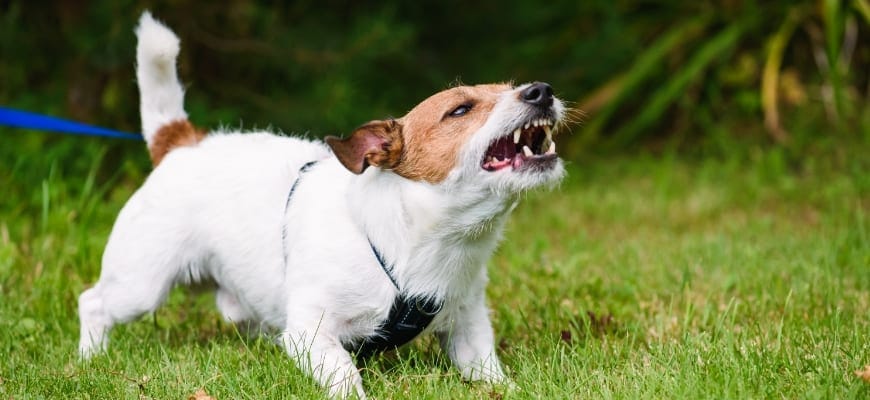
Some dogs experience something called leash aggression, which could be lunging, barking, or growling, specifically when they are wearing a leash. Leash aggression could be because of discomfort with something around their neck.
Having a rope around their neck that controls their movements is uncomfortable for anyone, even a human! Make sure your dog has a loose collar fitting to minimize their pain if they are having a leash meltdown.
We had a lot of trouble with leash training one of my dogs. The difference was like night & day. Off-leash, he was the sweetest dog ever & he was even great with kids. However, with a leash on, he would try to bark at & bite other people & smaller dogs. That was when we knew we needed to really hone in on his leash skills, or lack thereof.
We spent more time slowly introducing the lead to him. First, we let him sniff it; then, we left him on a loose lead while we fed him treats to build a positive association. After a bunch of training sessions, we can now take him loose leash walking in safe areas.
Of course, he still has a bit of aggression & behavior issues, but thanks to consistent training, they are a lot better than before!
3. Feeling scared/uncomfortable
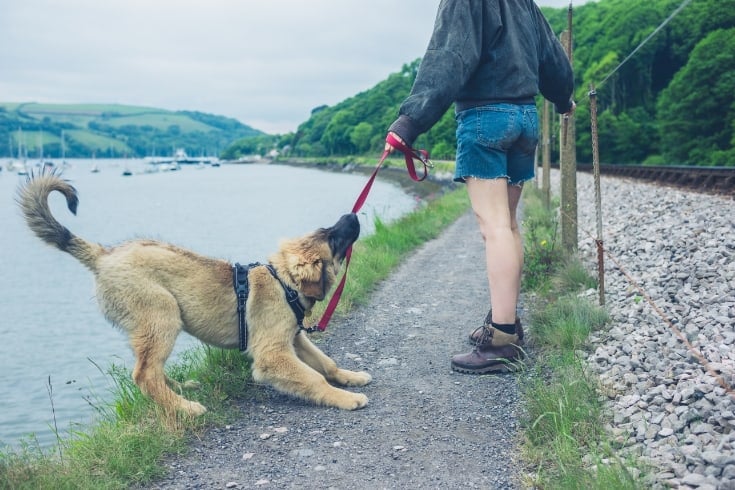
Have you ever wondered why it is so easy to train dogs? Because they are very quick to make lifelong, meaningful associations. So, if you say “Sit” while they are sitting, they will associate the verbal command with that specific action.
Plus, if you reward them, they will associate following your commands with tasty food, which makes them want to do it more!
However, the flip side of this is that dogs can quickly make negative associations as well. People who have rescue dogs might have noticed that their pup refuses to wear a leash. When the leash is put on, the pooch might whine, wince, and won’t even eat his favorite treat.
This could be because of a previously existing negative association with leashes, which led to trust issues. In the dog training world, these are known as “poisoned cues,” and they can cause your dog to become super anxious. To help them become more comfortable with the idea of walking on a lead, work in baby steps.
Start with only leaving a loose leash on them and reward them for a minute of positive behavior. Throughout this time, keep giving him pats & verbal praise. If your dog starts to whine, bark, or shake his head, do not reward him.
After a period of time, hold the end of the lead in your hand and go through some other tricks like sitting and lying down.
Your dog should slowly get used to a little bit of tension on the lead. Make sure you continue to give him delicious treats throughout this whole process! After a short period of time, you will be able to slip on a lead & your dog won’t even react to it!
Then, you may begin with leash training by teaching him the “heel” command.
4. Overly excited
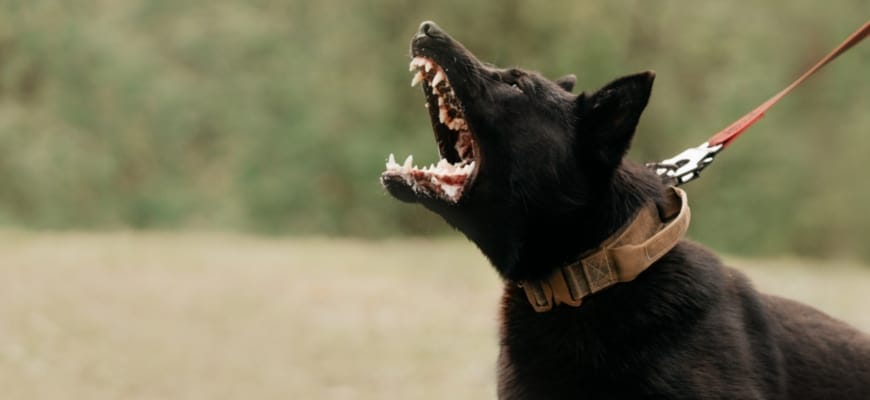
You may find that your dog is way too excited as soon as you try to hook a leash on. This is a super common phenomenon in most young pooches because they realize that they are going outside.
They may start barking & zooming around as soon as they hear the word W-A-L-K! To combat this, you need to show your dog that if they are super reactive, there is no chance they can go outside.
If they start displaying any behavioral issues like incessant vocalization, panting, or jumping, make them sit while you are still in the house before you start your walk. Making them sit on a loose leash gives you an opportunity to look in their eyes, tell them to calm down, and make them await your instructions.
Then, slowly walk towards the door. If they start getting over-excited again, simply sit them down again and wait for a few minutes. Eventually, they will understand that if they continue to jump, there is no way they are leaving the house.
5. Allergic to the material
There’s also the possibility that your pooch is allergic to the material of the lead or their collar. So, each time you pull on the leash, it irritates their lesions or blisters, which makes them antsy each time you make them wear the lead.
The type of leash matters a lot. You need to invest in a high-quality lead because cheap dyes & metal alloys can easily cause an allergic reaction on your dog’s skin. Some tell-tale signs of a reaction to the leash are hives, swelling, incessant itching, and redness.
It should be visible everywhere that the lead has touched your pup’s skin, but it’s possible to see signs of allergy in other areas.
If you notice these symptoms, you should change the leash & consult your veterinarian as soon as possible. They will likely administer an antihistamine and/or steroids.
6. Doesn’t like walks
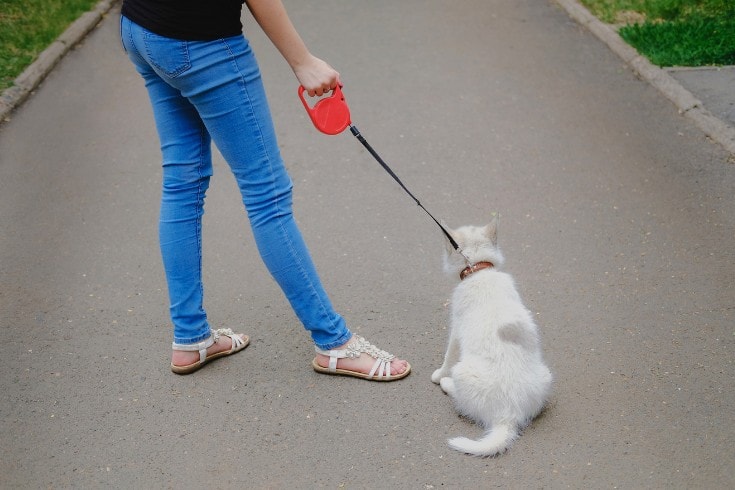
Since each and every dog is different, there is a chance that your pooch isn’t a huge fan of going out on walks! Although this seems impossible, some dogs, especially ones that struggle with anxiety, have a strong aversion to going outside of the house.
Certain puppies view the outside world as extremely uncomfortable. Maybe they find the noisy cars or the overstimulating parks to be too much to handle. Since they know that wearing a lead is the first step in leaving the house, they may stop you from putting the leash on.
They may also be tired and simply averse to exercise. Whatever it may be, try to pick up on clues from your dog’s body language. If your dog seems really low-energy in the house & refuses to move around, maybe push the walk by a few hours and give your dog some time to relax.
If your dog shows signs of anxiety, like lip licking or yawning, they are probably anxious about going out of the house. Remain patient and keep trying to slip the lead on your dogs. Reward them heavily with pup treats and praise if they allow you to put on a leash & take them outside.
Avoid super busy areas, like crowded dog parks or bustling intersections, as your puppy may find them overstimulating.
Frequently Asked Questions
These are a couple of commonly asked questions by pet parents about leash training & leash aggression.
How do I help my dog with leash anxiety?
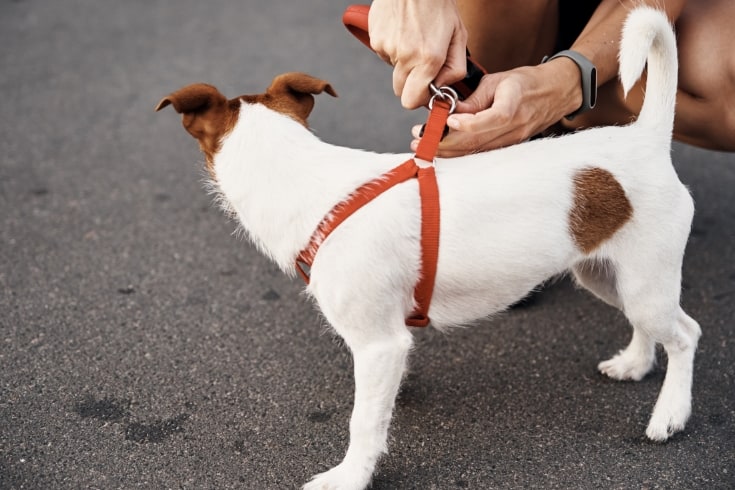
Some dogs get extremely anxious as soon as you clip on a leash. This could be due to an existing negative association. It’s important to make slow progress when you have a canine with severe leash anxiety.
To begin with, let your dog sniff & touch the leash in a safe environment. They need to learn that it isn’t a weapon or something to be feared. Then, slowly put it around your dog’s neck.
If your dog refuses to let you get near, you may want to use a slip leash instead, as it requires less contact to put it on your pooch. Then, leave them on a loose leash as you pet them, go through a few basic tricks, and give them treats.
They need to learn that having a leash on doesn’t have to be a super uncomfortable experience.
Eventually, they will be fine with being on a lead, even with a bit of pressure.
How can I get rid of leash aggression?
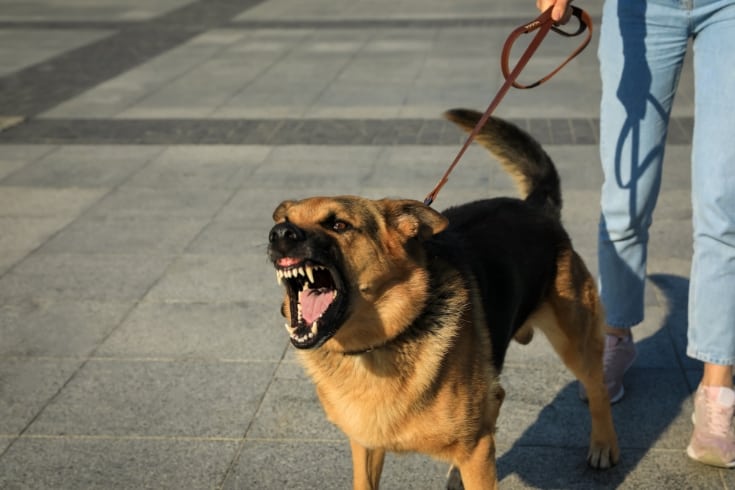
If your dog is struggling with leash reactivity, it’s extremely important to use positive reinforcement. A great tactic is to use clicker training to teach him the “Watch” Command.
This is a fantastic way to distract your dog from whatever he is being aggressive towards & to focus all of his attention on you. In fact, in certain dangerous situations, it may even be a life-saving skill.
Start the training for this technique at home, away from a bunch of distractions. Say the command “Watch” or “Watch Me” in a strong voice. Wait for your dog to look at you, and then click the clicker (or verbally praise them) and give them a puppy treat.
Eventually, when you say “watch,” your puppy will automatically look your way. At this point, you want to make sure that he holds eye contact for around 5 seconds & only then give him a click & a treat.
After a while, this behavior should be well-learned. Test it out in a crowded dog park, where your dog is likely to lunge. As soon as your puppy sees another dog & he is about to lunge or bark, use the “watch” command to divert his attention back to you.
This is a great way to distract an aggressive dog. Over time, as your puppy becomes more comfortable with being walked on a leash, they will stop lunging and barking!
How do you lead a stubborn dog?
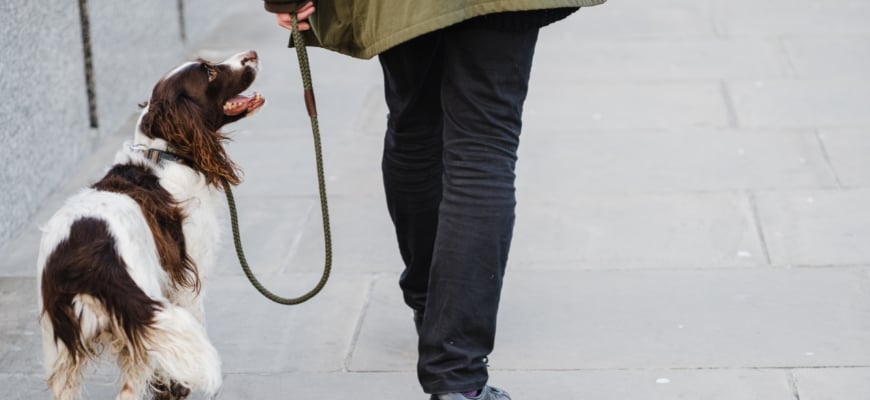
Your dog isn’t behaving stubbornly just to piss you off! It’s likely just unaddressed leash aggression or anxiety.
Follow the steps listed above to see if it improves your pooch’s walking habits. There is also a possibility that your dog is stubborn because he is tired & simply doesn’t want exercise.
In this case, give your dog a few hours to be a couch potato! After a quick recharge break, you should find that your dog is much more receptive to being walked.
It is also likely that your dog doesn’t want to go outside, probably because of anxiety. The noise & the smells could be overwhelming & overstimulating for him, which is why he stubbornly resists walking.
In this case, you should make sure that you slowly re-introduce him to the lead by letting him sniff it, keeping him on a loose leash, and then pulling gently & rewarding him when he comes.
Should you drag a dog that won’t walk?
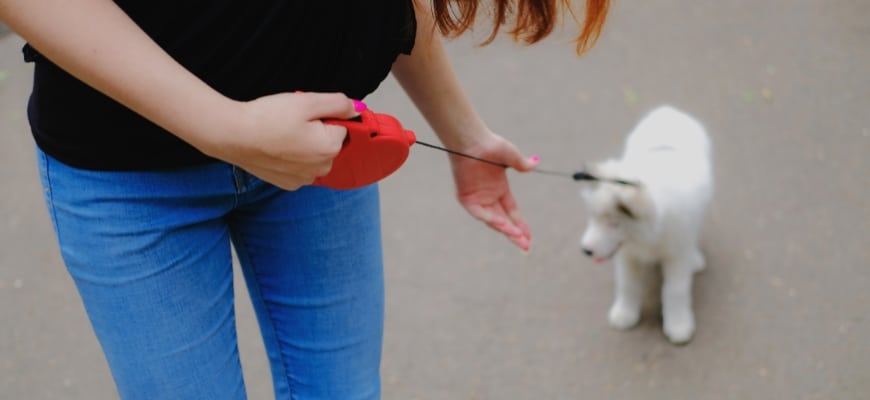
Dragging your dog is a huge no-no because it can cause lifelong negative associations to form between your pup & going on walks.
Firstly, dragging a dog can cause collar chafing and joint issues in young puppies. It can cause scraping on their sensitive paws & can cause back issues to develop later on in their life. Plus, it can also needlessly tire you out if you are dragging your pooch around 24/7.
If you find that your dog simply doesn’t want to walk, you should instead entice them with a puppy treat or verbal praise. You can also bring along your dog’s favorite toy & toss it ahead to keep the walk exciting & allow your dog to focus on something specific if he finds the sounds & smells overstimulating.
Sometimes, a dog can be totally averse to going on a walk, especially if it’s freezing or super hot outside. In this case, you may have to pick them up and carry them home. However, try not to resort to dragging them around as it may cause permanent damage.
How do I build my dog’s confidence on a leash?
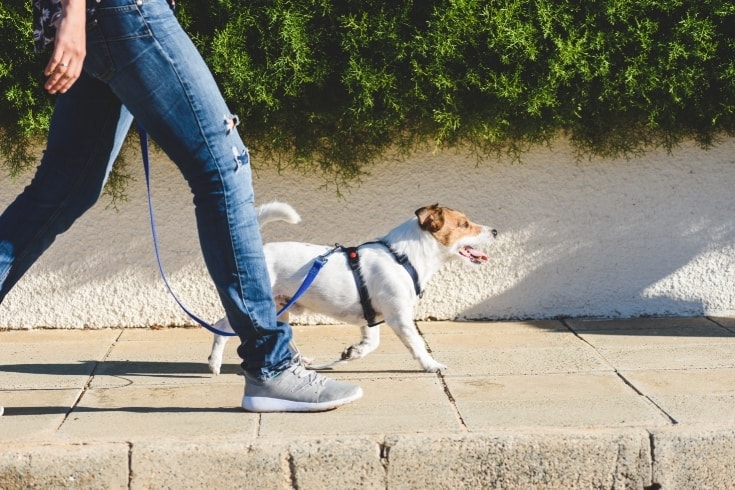
Leash training is a lifelong skill that all dogs must learn. However, the most important aspect of leash training is confidence. If your pup is still anxious & hesitant on walks, it will be extremely difficult for him to master leash training.
When you’re out on walks, let your pooch take the lead. Try out a bungee lead that gives him a lot more freedom to explore and allows you to quickly bring him back in case of an emergency.
Giving your dog a bit more freedom will make him a lot more comfortable with exploring the outdoors.
Make sure you enrich your dog’s life with tons of behavioral training & puzzle treats. These activities give your dog an invaluable sense of accomplishment, which will make him a lot more confident.
This will transfer to his behavior on walks; you will notice that he is much better behaved & a lot less scared.
Conclusion
Lead training is a tricky process for most first-time pet owners. It can seem totally hopeless when your dog won’t even let you put a leash on them!
They aren’t just doing it to piss you off. There are a ton of reasons why a dog might hate wearing a leash, and most of them have to do with an existing negative association.
Whether your pup is super anxious about the idea of going outdoors, or they are displaying signs of leash aggression, it’s important to introduce the leash slowly & with tons of rewards when your pup is listening to you.
It’s important to never drag your dog as this can cause permanent damage to your dog’s neck, joints, and paws.
Remember to be patient throughout this process! Your puppy is bound to make mistakes & it’s your job as a responsible owner to correct them kindly yet firmly.
If you found this article interesting, please share it with friends. If you have any questions, leave them down below!
Thanks for reading!
